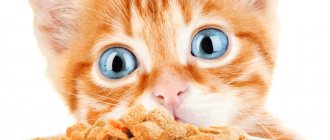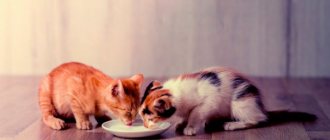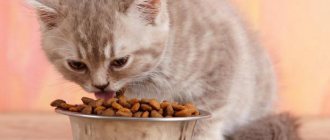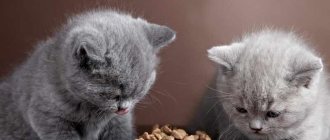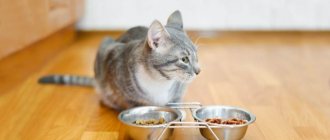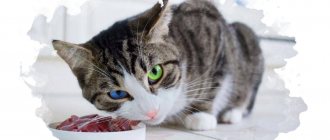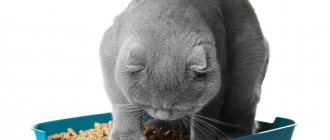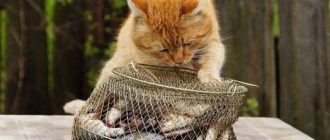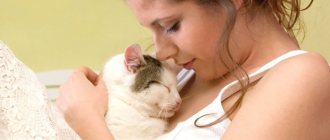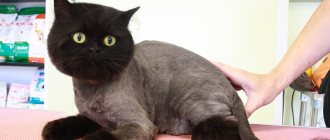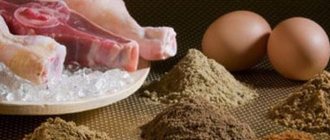4112Pavel
Every caring owner is concerned with the question: what should you not feed cats? After all, the bodies of humans and cats are different, and many foods that are good for us can be harmful to our pet.
In this article we will look at:
- what not to feed your cat;
- what not to feed a kitten;
- What products should spayed and sterilized animals be protected from?
© shutterstock
List of prohibited products
The following are unacceptable in the diet of any pet, regardless of age:
| Product | Effect produced |
| Chocolate and all products containing cocoa beans | They contain theobromine, which is deadly for cats, which accumulates in the liver, does not decompose, and is not excreted from the body. |
| Alcohol, beer, hops | They are also not excreted from the cat’s body. Inadmissible even in small quantities. |
| Coffee and tea | Any products with high levels of caffeine lead to extensive damage to the cardiovascular and nervous systems. |
| Mushrooms | Lead to severe poisoning, possibly causing immediate death. |
| Potatoes and tomatoes | They contain an alkaloid that promotes severe damage to the gastrointestinal tract (of course, if eaten in large quantities). In the form of puree or juice, the latter do not cause such severe consequences, but there is also no benefit from them. |
| Avocado | Contains persin, which is toxic to the cat's body. Diarrhea, vomiting, and difficulty breathing after eating this fruit are often fatal. |
| Garlic and onion | The disulfite they contain leads to the death of red blood cells and the development of anemia. |
| Rhubarb, sorrel | When they are consumed by cats, poisoning occurs with oxalic acid. May cause kidney failure. When cooked it leads to diarrhea. |
| Stone fruit seeds | Contains hydrocyanic acid, which causes suffocation. |
| Grapes (raisins), citrus fruits, persimmons | They provoke vomiting and diarrhea. |
| Boiled meat, chicken, fish bones | May cause injury and rupture of the intestine. |
Products undesirable in the diet of animals:
- Flour containing nutritional yeast and pasta products will lead to intestinal fermentation and diarrhea.
- Nuts and sunflower seeds in large doses lead to phosphorus poisoning.
- Peas and any legumes do not pose a mortal danger, but they lead to fermentation in the intestines.
- Broccoli contains isothiocyanates that can accumulate in the body; they are acceptable in limited doses.
- Raw and condensed milk and baby formula are harmful to the body of an adult cat. Also read: Can a cat drink milk?
- Raw eggs can cause coat problems due to the enzyme avidin in their composition.
- Fish and pork are allowed in minimal quantities.
- Goose meat, duck meat, and lard due to their high fat content can cause the development of pancreatitis.
- The liver contains many active substances, their excess leads to severe digestive disorders.
- Salt causes electrolyte imbalance in the body.
- Sugar reduces immune responses and leads to diabetes.
- Dry dog food is not recommended for cats; it can cause problems with the cardiovascular system. Read why cats can't eat dog food.
- Vitamins containing iron are unacceptable for people - they lead to disruptions in the functioning of all body systems.
Fatty, spicy, salty foods, preservatives lead to diseases of the gastrointestinal tract, liver, kidneys, diarrhea and vomiting.
Prohibited (dangerous) foods for kittens
Prohibited (dangerous) foods for kittens are foods that can cause serious illnesses, some of which are difficult to treat. The basic rule is not to feed your pet food from the owner's table, since it is not intended for animal nutrition.
The first on the list of prohibited foods are chicken, fish bones, skin and pure fat. They are listed separately because owners often make the mistake of giving these products to kittens.
Important! Cats, like other animals, need fat. However, they get enough of it from meat products, so additional sources (pure fat, skin) are not needed.
The danger of bones is damage to the mucous membranes, deep tissues of the esophagus or stomach. This causes bleeding. Often bones get stuck in the digestive tract and accumulate in the intestines. Chicken skin is dangerous because it accumulates hormones and antibiotics. It is difficult to digest.
Other prohibited products:
- sweet, juicy fruits - contain a lot of fructose, which is ideal for feeding bacteria and fungi. Cats are indifferent to fruit, so there is no reason to give it;
- grapes, raisins - become a cause of intoxication with constant consumption, which often leads to failure of the urinary organs;
- soybeans and corn grits are sources of “empty” calories. The products are not beneficial, are poorly digested and are almost not absorbed. Soybeans and corn often become the basis of cheap feed;
- semolina – contains a large amount of calories and does not benefit the growing body. Regular consumption will lead to the development of diabetes;
- freshwater fish - in its raw form is a source of parasitic diseases, for example, opisthorchiasis. It contains a large number of small bones, and is inferior in usefulness to sea fish;
- smoked, fatty, spicy, fried foods - provoke inflammation of the mucous membranes of the esophagus and stomach. Eating such foods disrupts the balance of microflora in the intestines;
- sweets (chocolate, candy, sugar, chewing gum) - lead to damage to teeth and fur, disrupt metabolic processes, and reduce immunity. Contains poisons for cats (xylitol, theobromine). Sweets often cause severe poisoning and death of the animal;
- stimulants (tea, coffee, cocoa) – regular use leads to disruption of the normal functioning of the nervous system. The exception is taurine, an amino acid essential for kittens.
It is forbidden to give kittens expired food, as this leads to poisoning and indigestion. This is explained by the high sensitivity of the digestive tract in cats.
Why can't adult cats have milk?
Kittens need mother's milk. If for some reason they are deprived of it, it is acceptable to replace it with special mixtures from a veterinary pharmacy, goat milk, 10 percent cow cream, or, in extreme cases, whole milk.
With the achievement of adolescence, the body undergoes a restructuring; animals produce less of the enzyme necessary for the complete absorption of milk. In adults, lactose intolerance occurs; the product is not broken down into simple sugars and absorbed into the blood. Fermentation occurs in the intestines of the individual due to lactic bacteria, which leads to bloating, increased gas formation and diarrhea.
Sour cream, butter and cheeses are also undesirable in a pet's diet due to their high fat and salt content.
Fermented milk products - kefir, acidophilus, fermented baked milk, sugar-free yogurt will not harm cats.
Feeding kittens at different stages of life
Feeding a small kitten at home can vary greatly depending on how old the baby is.
What to feed a newborn kitten
If kittens are only a week old, what should you feed them at home? Newborn kittens are usually fed by their mother. But a cat can abandon the cub, die or get sick; in general, the cases are different. If you find yourself in this situation, don't despair. There are many ways to feed newborn kittens at home with your own hands. So, the kittens are a week old, you don’t know what to feed, let’s start in order.
The best option for a kitten up to a month old is a wet nurse. To do this, you will need to find another cat that has recently given birth, who will become the baby’s foster mother for a while. If you live in a metropolis, then, thanks to the capabilities of social networks, there should not be any major obstacles to the implementation of this plan. But, of course, this is not always possible. In any case, a week-old kitten needs maternal colostrum to start life and this leads us to the second possible option.
A kitten can be fed for up to a month with a special mixture that imitates cat's milk. You can find the mixture at a pet store or veterinary pharmacy. If this point does not suit you, then you will have to feed kittens at home using products that are on hand. Recipe: In a ratio of 4 to 1, take boiled milk and egg white. The ingredients are thoroughly mixed, and the resulting mixture is fed to the kitten.
Also in this situation, infant formula (human) can help out. Only the mixture will need to be diluted two times thinner than what is written in the recommendations for using the product.
Rules for feeding a kitten 1 month
When the kitten grows up to 3-4 weeks, it is time to feed it with other food. At this stage, kittens begin to gradually move away from their mother's nipple and are ready for new achievements. To ensure that the stages of transition to adult food do not affect the well-being of the baby and do not lead him to a stressful state, complementary feeding begins with food close in consistency to milk. Baby meat puree, rich in protein and vitamins, is a good choice for this purpose. You can also prepare puree mixtures yourself. For more information about feeding kittens at 1 month old, follow the link.
What to feed kittens at 2 months
The rules for feeding two-month-old kittens are not very different from the principles for feeding one-and-a-half-month-old animals. The main change can be considered the introduction of dry food into the diet. Also, by this time, you can feed the animal not just puree, but give it more solid food, that is, do not grind or grind the food. The amount of food consumed increases as the kitten grows, so you can feed it with a large amount of cottage cheese, offer your pet greens, try giving grated vegetables - cabbage, pumpkin, carrots.
If in your case the only solution to solving feeding problems is store-bought food, then provide your pet with a quality product. In any case, the diet of kittens for 2-3 months can be diluted with raw yolk. Keep in mind that kittens of such a young age are still inexperienced in matters of food consumption and if you do not control the process, the pet can easily overeat. For more information about feeding kittens at 2 months, follow the link.
What to feed kittens at 3 months
The issue of feeding a three-month-old kitten must be approached with great attention. The point is this: three months is the age at which a kitten’s teeth begin to change, and in order for the teeth to grow normally, the pet needs food on a solid basis.
This is the right age to include raw meat in an animal's diet. Keep in mind that meat is one of the main sources of helminth infection. Therefore, three months of age is also the time to worm a kitten.
It is already easier to feed a grown animal than a small kitten. He can already chew small bones; he no longer has to chop up the meat and remove every vein. In addition, from 3 months the animals begin to monitor the amount of food they consume and this issue should no longer bother you so much. What is the best way to feed a kitten for 3 months:
- raw grated vegetables (soft ones can be cut into pieces);
- raw, cooked meat;
- boiled lean fish without bones;
- milk porridge.
- yogurt, cottage cheese.
Another advantage of the baby growing up is the change in the number of “snacks”. If at the initial stage the baby had to be fed up to 10 times a day, day and night, now you can switch to three meals a day. For more information about feeding kittens at 3-4 months, follow the link.
What to feed a kitten 5 months and older
By this age, the kitten becomes almost an adult. Of course, he still continues to grow and develop, but you can feed a five-month-old kitten with food that adult animals eat, and this is much easier than feeding a dairy kitten. The only thing is, try to choose food, taking into account the pet’s preferences, which should already have formed by this time. If it is possible to sprout grass for cats, do it. For your pet, this will be a good, additional source of useful minerals and vitamins.
Feeding tips
- Food for kittens must be fresh. As an exception, kefir can be distinguished; before feeding the pet, it is usually kept in a cool place for several days.
- Delicious sausage, smoked meats and other aromatic delights that can make a cat salivate, but a cat can’t, there are a lot of spices that are harmful to the animal. Therefore, do not give in to the persuasion of the mustachioed muzzle, because the health of the animal is higher than satisfying a momentary desire.
- There is no need to heat up your kitten's food, but you also shouldn't feed your kitten food that is too cold. The most optimal food temperature is room temperature.
- Change your kitten's water every day, and don't forget to wash the cup. It is better not to use detergents; running water is more than enough in this case.
- Even if the pet is already quite old (4-5 months), it can still grind especially large and coarse pieces of food.
In order for a kitten to live with you easily and carefree, it needs to be fed properly - this is one of the important components of the health and longevity of the animal.
Fish for cats - benefit or harm
Fish and any seafood are not included in the list of absolutely prohibited foods, but they should be included in the diet of pets with caution.
Fish should only be sea and fresh, not containing feed additives (not grown in factories or farms).
There is no point in giving it boiled, since heat treatment reduces the content of enzymes and therefore microelements will not be absorbed.
The catch from the river most likely contains helminths, and the pet will be infected, and if the fish is boiled, it will be useless. Of course, all varieties of carp are prohibited, since their consumption leads to the destruction of vitamin B1 and liver damage.
It is permissible to give cats no more than once a week low-fat and fresh sea species: hake, cod, sardines, trout, peeled and scalded shrimp and squid. But in order to feed an animal with such seafood, you need to live on the seashore or ocean.
Since it is now almost impossible to purchase high-quality sea fish in stores, it is recommended to exclude it from the diet of modern cats.
Why you can’t feed your cat fish: a healthy eating algorithm
When studying what you should not feed a cat, you should understand that in nature, mustachioed-striped purrs do not eat fish, since they cannot catch it. Many people push seafood at us, considering it healthy and indispensable. To the question: why can’t you feed a castrated cat fish? I will answer unequivocally - it contributes to the development of urolithiasis. If your diet includes seafood, then I recommend following the rules:
- Add fish to the diet no more than once every 7-10 days.
- Before you put the fish in a bowl, you need to remove all the bones, because it can be a choking hazard.
- The raw product is not suitable for feeding - the fish must be boiled for at least 5 minutes.
Important! Freshwater fish is not suitable for the diet - it is bony and can also become a source of infection with various helminths.
The dangers of low-quality dry food
Industrially prepared dry and wet cat foods are the simplest nutritional option. But for them to be useful, their composition must be balanced. Proteins, fats, carbohydrates, vitamins, micro- and macro-additives must be contained in the required proportions. Read about the composition of industrial feeds.
Not all industrial mixtures meet such strict requirements. Compositions with a meat content of 50 percent or more deserve a satisfactory rating. Such foods belong to the super premium and holistic classes (Acana, Orijen, GO!). Read our review of the best foods for cats and kittens.
Cheap mixtures, such as Whiskas or Kiteket, contain a lot of vegetable grains and fats; they are not recommended for complete nutrition of pets.
Manufacturers achieve the attractiveness of such cat food through flavoring additives and aromas, which also cause harm to animals.
Dry mixtures containing a high content of soy, wheat, corn, and hydrolysates (artificial proteins) should be avoided. If the components are named with the general term “meat” or “fish”, then this is an undefined raw material and you cannot buy such a product.
The best foods contain more than 70 percent quality meat or fish, whether raw, dried or processed. The composition must be described in detail, indicating the percentage of components.
What not to feed kittens
All prohibited products for adult animals are also unacceptable for young animals. The only difference is that kittens up to six months old are able to digest milk and dairy products.
Mixed nutrition with the simultaneous inclusion of natural food in the diet, for example, raw poultry meat and dry industrial feed, is unacceptable for babies. The fragile gastrointestinal tract is not capable of such stress.
It is better to give meat in the form of minced meat, gradually transferring two to three month old babies to unground food.
Kittens should have small meals - up to six times a day.
Undesirable (controversial) foods in the diet
Undesirable (controversial) foods in the diet are foods that do not exhibit harmful effects on their own. However, with long-term use it can cause health problems.
Examples of the main controversial products:
- Chicken, pork, beef liver. Regular inclusion of offal in the diet will lead to a glut of fat-soluble vitamins - retinol and cholecalciferol. Hypervitaminosis is no less dangerous than a lack of these substances. Veterinarians recommend turning on the liver no more than 1-2 times a week.
- Legumes (beans, peas), potatoes. These products are poorly absorbed by a fragile body, lead to bloating, and cause fermentation processes in the intestinal tract. An unpleasant consequence is indigestion.
- Sea fish, seafood. The reason for the controversy is the formation of stones in the bladder with constant inclusion in the diet. In the first months, it is better not to give the kittens fish at all. The second reason is the likelihood of helminth infection. Heat treatment (freezing or cooking) is considered the main method of killing parasites. It is worth considering that seafood loses some of its beneficial properties.
- Steamed pork. The main reasons why this meat is considered a controversial product are its high fat content, the frequent presence of helminths, and the likelihood of infection with false rabies. When cooked for a long time, pork is allowed in the diet.
- Cow's milk. The product becomes a common cause of digestive disorders (diarrhea, diarrhea, flatulence). This is due to individual intolerance to milk sugar (lactose). It develops in 40–50% of kittens over four months of age. If unpleasant symptoms are detected after drinking milk, the baby is switched to fermented milk products.
- Chicken eggs, industrial chicken. The former cause an allergic reaction, which often leads to anaphylactic shock. The norm recommended by veterinarians is no more than 2 eggs per week, but quail eggs are allowed to be included in the diet. Factory-bred chicken contains a lot of salt. Poultry is often raised on antibacterial drugs and hormones that can accumulate in the meat.
- Cereals. If the kitten develops normally and does not lag behind in growth, then it does not need cereal-based cereals. The body of a small animal itself is capable of synthesizing carbohydrates to ensure the normal functioning of organs and systems, so additional sources of nutrients will only be harmful.
Foods that are undesirable for kittens can cause problems with health and normal development. If you adhere to the recommendations and standards provided by veterinarians, you are allowed to include these products to diversify your diet.
Why you can't feed cats from the owner's table
The pet often hangs around when the whole family is having lunch or dinner. It is unlikely that he is hungry, he just requires attention. You should not give him food from plates - most likely, this is food that is strictly prohibited. And this will not add education to the cat.
In addition, human food contains many additional additives (spices, oils, salt, sugar, sauces) that will not bring any benefit.
It is better to feed the cat beforehand or put food in his bowl before lunch. A well-fed animal will quickly wean itself from asking for handouts.
If you want to pamper your pet, it is better to give him a piece of raw meat - veal, beef or chicken, turkey. The only condition is that the product must be frozen for at least three days in the freezer and thoroughly washed with cold water.
Quality water
The cat has a special kidney structure. At first glance, her fluid requirement is lower than that of a person, and her urine is therefore more concentrated. But your pet still needs quality water every day.
This can be bottled, spring or well water, or any purified and filtered water.
The drinking bowl should be made of stainless steel or earthenware. If it is plastic, then its quality is only acceptable, since cheap material can release harmful substances.
